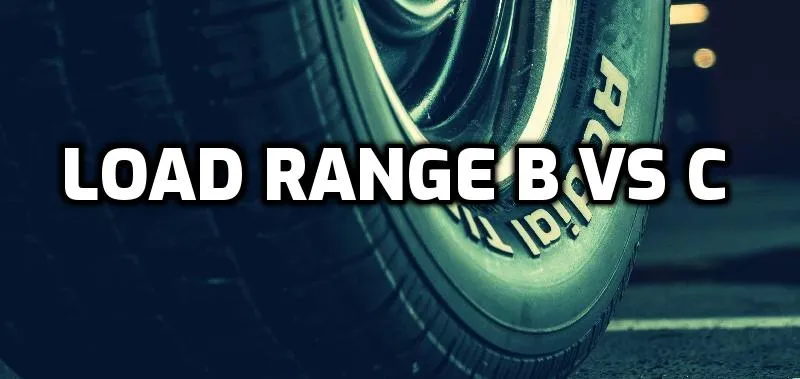Tires Load Range b vs c

The most common tire load ranges for light trucks in the tire market are B, C, D, and E. Understanding load range is an absolute must for you if you are interested in shifting tire sizes or types. It is the indicator to determine the maximum level of load that a tire can support in the maximum air pressure. We invite you to take a tour through the load range B and C confrontation to learn further detail.
Why Compare
The Main Difference between tire load ranges b and c are in the capacity to carry weight. Trailer tires with a lower load range B have less capacity than trailer tires with a higher load range C. The only difference between them is their psi and ply ratings.
A higher load range tire size of the same size may last somewhat longer than a lower load range tire size, but it won’t improve the trailer’s carrying capacity. However, this does not mean that the C tire is less capable than B – it just means it has a lower weight carrying capacity.
Being a non-automotive person, many people are confused about choosing between these two types of load ranges. They wonder whether there are any differences apart from the ply and psi ratings. Which one would be long-lasting?
Which one is harder? What is the basic difference that differentiates the performance? A side-by-side comparison is prepared with all the necessary data to answer all these relevant questions. Look at the table below, where the key points are highlighted.
Load Range C vs B Table
Load Range B | Load Range C |
Ply Rating is 4 | Ply Rating is 6 |
Markingson tire B | Markingson tire C |
Maximum Load Pressure is 35 psi (240 kPa) | Maximum Load Pressure is 50 psi (350 kPa) |
Longevity is Less Durable | Longevity is More Durable |
Maximum load of 1,430 lbs. at 35 p.s.i | Maximum load of 1,760 lbs. at 50 p.s.i |
Speed Rating is 50 (km/h) | Speed Rating is 60 (km/h) |
The chart above clearly shows that the main difference lies in the ply and psi ratings. The range B tires are lower in loading capacity than the range C. Being higher in range, the latter will last longer consequently. Reasonably the size should remain the same. Only then is this condition applicable.
Speaking of the size of trailer tires, they vary in capacities with different ranges in carrying loads. For example, the Kenda 4.80-12 Bias Trailer Tire with a 12-inch white wheel, #AM30660 is a C range tire with a capacity of 990 lbs at 90 psi.
The exact tire with the rating of #AM30580 has a capacity of 785 lbs at 60 psi; hence, it belongs to range B. The B-rated tires will carry the maximum load if only inflated to 35 lbs per square inch. That means maximum inflation ensures maximum load carrying. In the case of C-rated tires, they should be inflated to a maximum of 50 lbs per square inch.
It is not always recommended to inflate them to the maximum air pressure. It would be best to do it only when the maximum capacity is required. A tire featuring load measurement B means that it is limited to the load capacity which can be carried at the inflation pressure of 35 psi. These tires can perform best between 100-115 mph.
On the other hand, the C-rated tires remove heat best at the speed of 85-100 mph. Sometimes you may face C1 or C2 as load range. Although they have the same number of piles, they differ in the maximum pressure. That means both C1 and C2 are six-ply rated. But the maximum air pressures are 50 psi and 35 psi, respectively.
If you are curious enough to learn more about the range C LT tires, you may visit our discussion on SL vs xl load range. However, another difference between these two light truck appliances is weight capacity. The 4-ply-rated range B tire can sustain a maximum load of 1430 lbs. The 6 ply rated C-rated tire can support a load of 1760 lbs altogether.
Load Range B Weight Capacity?
The load range B weight capacity is limited to the load carrying capacity which can be supported at an inflation pressure of 35 psi. A load range B tire can hold up to 1430 pounds.
Load Range C Weight Capacity?
The load range C weight capacity is limited to the load carrying capacity which can be supported at an inflation pressure of 50 psi. A load range C tire can hold up to 1760 pounds.
Our Recommendation
While replacing your tires with a new set, try to increase the load limits and ply rating. Never decrease. Also, do not ever exceed the wheel’s load rating while choosing a higher-ranged tire. Another noteworthy point we would like to mention. Please remember that a similar size tire with a higher load capacity will not add any capacity to the trailer. To increase capacity, the psi and ply ratings are important.
Frequently Asked Questions (FAQ)
Final Words
Having mentioned all the key points of both the load ranges, we suggest choosing your appropriate one. Of course, both work amazingly for carrying heavy loads. Still, you have all the necessary information to make a wise decision.
Our load-range conversation may become fruitful documentation only when the consumers benefit. We hope to clear all the confusion regarding the facts. If you notice further distinctions, don’t forget to let us know.
